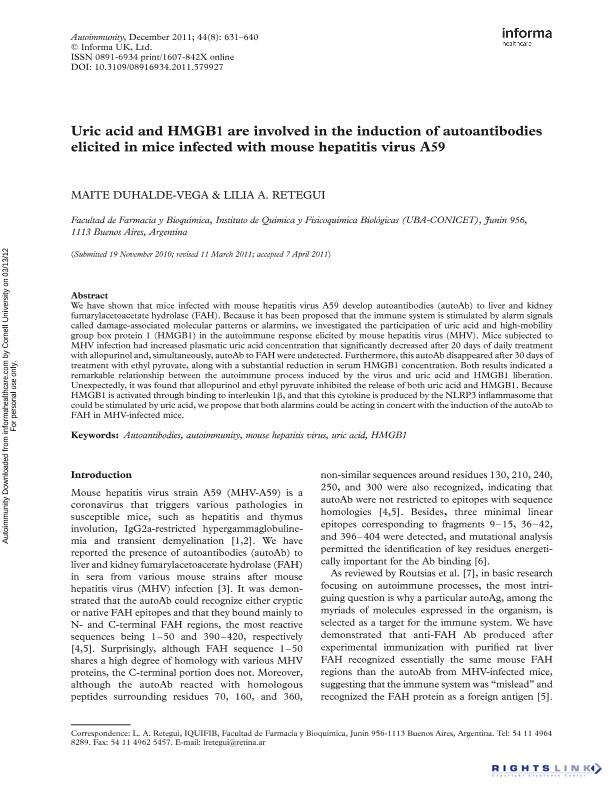Artículo
Uric acid and HMGB1 are involved in the induction of autoantibodies elicited in mice infected with mouse hepatitis virus A59
Fecha de publicación:
12/2011
Editorial:
Taylor & Francis
Revista:
Autoimmunity
ISSN:
0891-6934
Idioma:
Inglés
Tipo de recurso:
Artículo publicado
Clasificación temática:
Resumen
We have shown that mice infected with mouse hepatitis virus A59 develop autoantibodies (autoAb) to liver and kidney fumarylacetoacetate hydrolase (FAH). Because it has been proposed that the immune system is stimulated by alarm signals called damage-associated molecular patterns or alarmins, we investigated the participation of uric acid and high-mobility group box protein 1 (HMGB1) in the autoimmune response elicited by mouse hepatitis virus (MHV). Mice subjected to MHV infection had increased plasmatic uric acid concentration that significantly decreased after 20 days of daily treatment with allopurinol and, simultaneously, autoAb to FAH were undetected. Furthermore, this autoAb disappeared after 30 days of treatment with ethyl pyruvate, along with a substantial reduction in serum HMGB1 concentration. Both results indicated a remarkable relationship between the autoimmune process induced by the virus and uric acid and HMGB1 liberation. Unexpectedly, it was found that allopurinol and ethyl pyruvate inhibited the release of both uric acid and HMGB1. Because HMGB1 is activated through binding to interleukin 1β, and that this cytokine is produced by the NLRP3 inflammasome that could be stimulated by uric acid, we propose that both alarmins could be acting in concert with the induction of the autoAb to FAH in MHV-infected mice.
Palabras clave:
Autoantibodies
,
Autoimmunity
,
Mouse Hepatitis Virus
,
Uric Acid
,
Hmgb1
Archivos asociados
Licencia
Identificadores
Colecciones
Articulos(IQUIFIB)
Articulos de INST.DE QUIMICA Y FISICO-QUIMICA BIOLOGICAS "PROF. ALEJANDRO C. PALADINI"
Articulos de INST.DE QUIMICA Y FISICO-QUIMICA BIOLOGICAS "PROF. ALEJANDRO C. PALADINI"
Citación
Duhalde Vega, Maite; Retegui, Lilia Alicia; Uric acid and HMGB1 are involved in the induction of autoantibodies elicited in mice infected with mouse hepatitis virus A59; Taylor & Francis; Autoimmunity; 44; 8; 12-2011; 631-644
Compartir
Altmétricas




